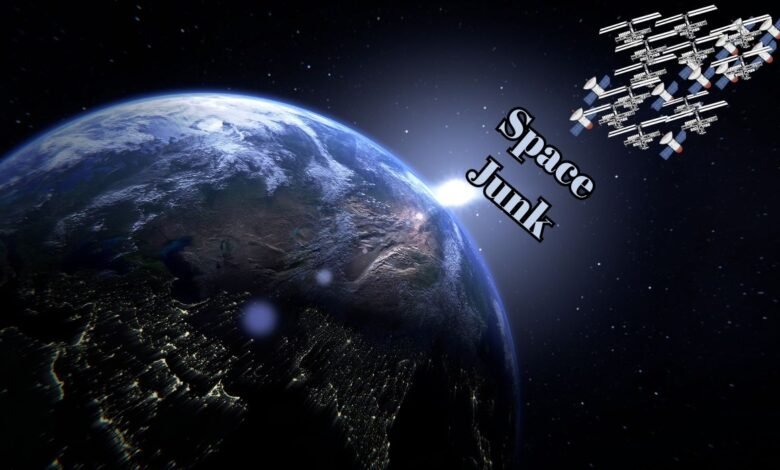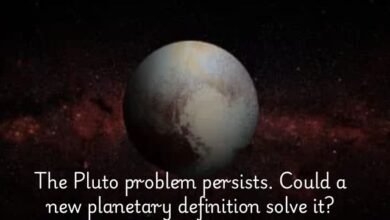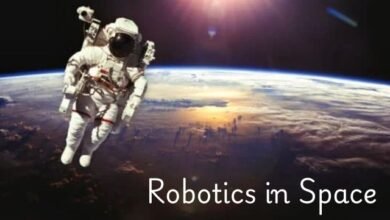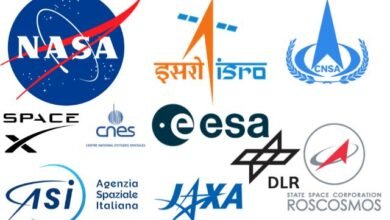Space Junk: What is it and how does it affect us
Learn about space junk and its impact on Earth and space missions. Understand the threats posed by orbital debris.

Space junk, also known as space debris, refers to non-functional, human-made objects that orbit the Earth. These objects range from defunct satellites and spent rocket stages to fragments resulting from collisions or disintegration of larger structures. As the volume of space junk increases, so does the potential for disruptive impacts on current and future space missions. Understanding the nature and challenges posed by space junk is thus crucial for the sustainability of space activities.
The types of space junk are diverse. Defunct satellites, which are no longer operational, contribute a significant portion to the debris cloud. Spent rocket stages, left behind after launching payloads into space, also add to the accumulation. Additionally, fragments from collisions between objects or from explosions in space exacerbate the problem by creating numerous smaller pieces of debris. These objects can travel at extremely high velocities, making even minute particles hazardous to active satellites and space stations.
The importance of addressing space junk stems from its potential impact on space operations. As the volume of debris increases, so does the likelihood of collisions. These collisions can damage or destroy valuable assets, such as satellites that provide critical services like communication, weather forecasting, and global positioning systems (GPS). Moreover, the safety of human space missions is also at risk, with the International Space Station (ISS) needing regular adjustments to avoid debris.
Given the growing dependence on space-based technologies and the plans for future space exploration, it is imperative to develop effective strategies for managing space junk. Efforts such as tracking and monitoring debris, implementing debris mitigation guidelines, and exploring active debris removal technologies are essential for ensuring long-term sustainability in space. By addressing these challenges, we can safeguard the domain of space for generations to come.
Types of Space Junk
Space junk, also known as orbital debris, encompasses a wide range of non-functional, human-made objects orbiting Earth. These objects vary significantly in size and origin, contributing differently to the challenges posed by space debris. Below are some of the most common types of space junk:
- Discarded Satellites: These are satellites that have outlived their functionality but remain in orbit. They can be as large as a bus and pose a significant risk due to their size and mass.
- Rocket Stages: After launching payloads into space, rocket stages are often left behind. These can include the upper stages of rockets, which are large and heavy, adding to the potential hazard.
- Non-operational Spacecraft: Spacecraft that have failed or are no longer in use contribute to space junk. These can range from small scientific probes to larger spacecraft.
- Fragmentation Debris: This type of debris results from explosions or collisions in space, producing thousands of smaller fragments. These fragments can travel at high velocities and pose a risk to operational spacecraft.
- Paint Flecks: Tiny flecks of paint that have chipped off spacecraft or rockets. Despite their small size, their high speed can cause damage to other objects in space.
- Metal Fragments: Small pieces of metal, such as bolts or shards from spacecraft, contribute to the debris field and can be hazardous due to their speed and trajectory.
- Lost Tools: Astronauts occasionally lose tools during space missions, which then become part of the space junk environment. Items like wrenches or gloves, although small, can still be dangerous.
The diverse nature of space junk underscores the complexity of managing and mitigating its impact on both current and future space missions. Addressing this issue requires a comprehensive understanding of all types of debris and their potential risks.
Current Extent of Space Junk
The issue of space junk has become increasingly prominent as the number of debris objects in Earth’s orbit continues to rise. Currently, space agencies around the world, including NASA and the European Space Agency (ESA), are monitoring an astounding number of objects. As of the latest reports, more than 27,000 pieces of space debris are actively tracked. These pieces range in size from tiny fragments millimeters across to defunct satellites and spent rocket stages.
NASA, along with ESA and other global entities, employs sophisticated tracking systems to monitor these objects. These systems use radar and optical telescopes to detect and catalog debris, maintaining a comprehensive and up-to-date database. The debris is classified based on size and potential threat level. Objects larger than 10 centimeters are meticulously tracked due to their capacity to cause significant damage to operational satellites and spacecraft. Smaller fragments, although harder to monitor, are also a concern due to their high velocities and potential to puncture spacecraft hulls.
The categorization of space junk is essential for prioritizing risk and implementing mitigation strategies. Space agencies classify debris into various tiers, such as low, medium, and high-risk objects, depending on their size, velocity, and orbit. These classifications help in formulating collision avoidance maneuvers for operational satellites and the International Space Station (ISS).
In recent years, the proliferation of satellite constellations, such as those for global internet services, has further exacerbated the space junk problem. The increased launch frequency has resulted in a higher likelihood of collisions and consequently, more debris. Agencies like NASA and ESA are working tirelessly to develop methods for debris removal and mitigation, ensuring the future safety and sustainability of space operations.
Impact on Satellites and Space Missions
Space junk, or orbital debris, significantly endangers operational satellites and manned space missions. This debris, ranging from defunct satellites to fragments of old rockets, poses a collision risk to active spacecraft. Even tiny pieces of space junk can cause substantial damage due to their high velocities.
Potential collisions with space debris can compromise the functionality of satellites, which are crucial for communication, weather forecasting, and global positioning systems. A single collision can create thousands of additional debris fragments, compounding the problem and increasing the risk for other spacecraft.
To mitigate these risks, space agencies and satellite operators employ several strategies, including:
- Satellite Maneuvers: Active satellites can be equipped with propulsion systems to execute evasive maneuvers, avoiding potential collisions with identified debris.
- Shielding: Spacecraft can be designed with protective shielding to withstand impacts from smaller debris, reducing the likelihood of critical damage.
Despite these measures, incidents involving space junk are not uncommon. For instance, in 2009, the collision between an operational Iridium communications satellite and a defunct Russian Cosmos satellite resulted in a significant increase in space debris. Additionally, in 2021, the International Space Station (ISS) had to perform an emergency maneuver to avoid a potential collision with a piece of debris from an old satellite.
Such incidents underscore the growing challenge posed by space debris. With the increasing number of satellites being launched, the density of space junk in Earth’s orbit is expected to rise, necessitating further advancements in debris tracking and collision avoidance technologies.
Efforts are also underway to develop debris removal technologies, such as robotic arms and nets, to actively reduce the amount of space junk. However, these solutions are still in the experimental stages and face significant technical and financial hurdles.
Overall, the impact of space junk on satellites and space missions is a critical issue that requires ongoing attention and innovative solutions to ensure the sustainability of space activities.
Environmental Concerns
Space junk, also known as space debris, poses significant environmental hazards both in outer space and on Earth. One of the most pressing concerns is the potential for the Kessler Syndrome. This scenario, theorized by NASA scientist Donald J. Kessler, posits that as the density of objects in low Earth orbit increases, collisions between these objects could produce a cascade effect. Such collisions would generate further debris, exponentially increasing the likelihood of subsequent collisions. This chain reaction could make specific orbits extremely hazardous and potentially render them unusable for future missions.
On Earth, space junk re-entering the atmosphere presents another set of risks. While most debris burns up upon re-entry, larger pieces can survive and reach the ground, posing threats to people and property. Although the probability of being struck by falling space debris is low, the potential for damage is non-negligible. Noteworthy incidents include the re-entry of the Skylab space station in 1979, which scattered debris across Western Australia, and the more recent uncontrolled descent of China’s Long March 5B rocket in 2020, where parts landed in the Indian Ocean.
The environmental impact of space junk is not limited to potential ground damage. The presence of debris in orbit can interfere with satellite operations, affecting communication networks, weather forecasting, and even national security. Additionally, the proliferation of space junk complicates efforts to launch and maintain new satellites, increasing the costs and risks associated with space exploration and commercial activities.
Efforts are underway to mitigate these environmental concerns. Space agencies and private companies are exploring methods to track, remove, and manage space debris. However, international cooperation and regulatory frameworks will be essential to address the growing problem of space junk effectively.
Efforts to Mitigate Space Junk
Efforts to mitigate space junk have become a critical focus for space agencies and private companies worldwide. The increasing amount of debris in Earth’s orbit poses significant risks to both manned and unmanned space missions. To address these challenges, various initiatives have been developed to reduce and manage space debris effectively. Below are some key efforts currently underway:
1. Satellite Deorbiting: One of the primary strategies involves the deorbiting of defunct satellites. This method ensures that non-functional satellites re-enter the Earth’s atmosphere and burn up, significantly reducing the amount of space debris.
2. Debris Removal Missions: Several missions are specifically designed to capture and remove space debris. For example, the European Space Agency’s (ESA) ClearSpace-1 mission aims to deploy a robotic arm capable of capturing large pieces of debris and safely removing them from orbit.
3. International Guidelines: The implementation of international guidelines and best practices is essential for mitigating space junk. Organizations such as the United Nations Committee on the Peaceful Uses of Outer Space (COPUOS) have developed comprehensive guidelines to encourage responsible behavior in space activities.
4. Active Debris Removal Technologies: Innovative technologies are being developed to actively remove debris. This includes the use of nets, harpoons, and laser systems to capture or deorbit space junk. Japan’s JAXA is working on the ELSA-d mission, which aims to demonstrate the feasibility of using magnetic capture mechanisms to remove debris.
5. Satellite Design Improvements: Enhancements in satellite design are also being implemented to reduce future space debris. This includes incorporating end-of-life disposal plans and ensuring that satellites have the capability to deorbit themselves once their operational life is over.
6. Space Traffic Management: Effective space traffic management systems are being developed to monitor and predict the movement of objects in space. This allows for better coordination and avoidance strategies to prevent collisions, thus reducing the creation of new debris.
These initiatives represent a concerted effort by the global space community to address the growing problem of space junk. By implementing these strategies, we can work towards a safer and more sustainable space environment for future generations.
Future Prospects and Solutions
As the issue of space junk continues to grow, the need for effective management strategies has never been more pressing. One of the key future prospects for managing space debris lies in international cooperation. Collaborative efforts among nations, space agencies, and private companies are crucial to developing and implementing sustainable space practices.
By establishing global norms and regulations, the international community can work towards minimizing the generation of new debris and mitigating the risks posed by existing space junk.
Innovative technologies play a pivotal role in addressing the space debris problem. Concepts such as space tugs, which can capture and move defunct satellites to safer orbits or deorbit them entirely, are gaining traction. These space tugs could serve as essential tools for clearing congested orbits and preventing collisions. Additionally, the use of ground-based or space-based lasers to nudge debris into lower orbits, where they would burn up upon re-entry, is being explored as a viable solution.
Robotic systems designed to remove or repurpose space debris represent another promising avenue. These advanced robots could autonomously identify, capture, and either deorbit debris or repurpose it for other uses, such as raw material for in-orbit manufacturing. This approach not only helps in cleaning up space but also promotes the efficient use of available resources, aligning with the principles of sustainability.
Sustainable space practices are essential for the long-term viability of space exploration and utilization. Both nations and private companies must commit to responsible behavior in space, including the adoption of best practices for satellite design, launch, and end-of-life disposal. By prioritizing sustainability, the space industry can ensure that future generations have the opportunity to explore and benefit from space without being hindered by the growing problem of space junk.
Effective management of space junk will require a combination of international cooperation, innovative technologies, and sustainable practices. By working together and leveraging cutting-edge solutions, we can tackle the challenges posed by space debris and pave the way for a safer and more sustainable future in space.
- Can meteorite strikes cause quakes on Mars?
- Chang’e-5 mission finds graphene on Moon, shaking up theories about our lunar neighbor’s formation!
- NASA Has Given a 1 Billion Dollar Deal to SpaceX: SpaceX to Deorbit the ISS Despite Options
Conclusion: The Importance of Addressing Space Junk
Space junk is more than just an eyesore; it poses real risks to our technology and safety. By understanding the problem and supporting efforts to mitigate it, we can help ensure a safer and cleaner space environment for future generations.
FAQ: Space Junk – A Looming Threat?
1. How much junk is left in space?
Estimates vary, but it’s a significant amount! Here’s a breakdown:
- Large Objects (>10 cm): Over 34,000 pieces are tracked by ground radar.
- Medium Objects (1-10 cm): An estimated 500,000 pieces are likely in orbit.
- Tiny Debris (<1 cm): Over 100 million pieces are believed to exist.
These are just estimates, and the actual number could be higher.
2. Why space junk is not a problem (This is a misconception!)
Actually, space junk is a significant issue. Here’s why:
- Collision Risk: Even small pieces can travel at incredible speeds, and a collision with a functional satellite could be catastrophic.
- Cascading Events: Collisions can create even more debris, leading to a snowball effect and a more dangerous environment.
- Limited Orbital Space: Certain orbits are crucial for communication and Earth observation. Space junk makes these areas more congested.
3. Can space junk hurt us on Earth?
Most space junk burns up upon re-entering the atmosphere, posing minimal risk. However, large objects could survive re-entry and cause localized damage.
4. Can we clear space junk?
Yes, there’s ongoing research on debris removal techniques. These include:
- Deorbiting Satellites: Techniques to nudge inactive satellites toward a fiery re-entry.
- Space Harpoons/Nets: Capturing debris for controlled de-orbiting.
- Space Lasers: Using lasers to vaporize small debris.
These technologies are still under development, and the best approach is likely a combination of methods.
5. Can we see space junk?
No, most space junk is too small to be seen with the naked eye. However, large pieces can sometimes be spotted with a telescope under very specific conditions.
6. Who has the most junk in space?
The United States and Russia have launched the most spacecraft historically, so they contribute the most tracked debris. However, all spacefaring nations contribute to the problem.
7. Who is responsible for space junk?
There’s no single entity responsible. International cooperation is crucial to develop debris mitigation strategies and responsible practices for future space missions.



